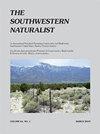ANELOSIMUS CF.ANALYTICUS(蜘蛛科:THERIDIIDAE)中的外国蜘蛛和昆虫在墨西哥索诺兰沙漠筑巢
IF 0.2
4区 环境科学与生态学
Q4 Agricultural and Biological Sciences
引用次数: 0
摘要
摘要蜘蛛属的蜘蛛是社会性的、亚社会性的和独居的。最近的一份报告称,这些物种中的一种对外来节肢动物在其蛛网中具有耐受性。在本研究中,我们报告了索诺兰沙漠南部90个Anelosimus cf. analyticus巢穴中节肢动物的多样性。我们从2015年3月至2016年11月和2017年1月取样。我们把巢分成小、中、大,计算蜘蛛和昆虫的数量。我们还统计了每种蜘蛛的雌蜘蛛、雄蜘蛛和幼蜘蛛。采用Shannon-Weaver (H’)多样性指数和EPielou(公平度指数)分析不同月份间的丰富度相似性。共发现48种昆虫栖息于巢中,其中67个巢中与其他种类蜘蛛和昆虫共存。蜘蛛产卵和蜕皮也很频繁。外来种集合在月份间的相似性不一致,但中小种的相似性值较低。从这些结果来看,我们认为分析斑腹沙蚕是一种亚社会性物种,其中小型巢穴在取样的几个月内有很大的活动和物种更替,不允许外来物种群体连续两个月以上建立。resume Arañas del gsamnero Anelosimus son sociales, subsociales by solitaria。所有的物种都描述了它们可以容忍的损失artrópodos foráneos。En este estudio reportamos la diversidad de artrópodos enos En 90 nidos de A. c . analyticus del del Desierto de Sonora。2016年11月,2016年11月,2017年11月。Los nidos看到separaron en pequeños, medianos y grandes, contando arañas e insect。tambisamicans感染了墨西哥的青少年,尤其是araña。解析:A.解析:A.解析:A.解析:A.解析:A.解析:A.解析:发现有48种生境类昆虫,67种生境类昆虫。Los ovisacos y mudas de la araña tamamicasten fueron freuentes。El conjunto de especies foráneas no mostró un patrón consistent de similud entre meses, pero los tamaños pequeños y medianos mostraron un valor de similud bajo。一个参与者的结果,考虑到a.c c . analyticus una especie subsocial cudos nidos pequeños y medianos tuvieran gran活动,通过rotación de especies durante los meses muestreados, lo que no permitió que groupos de especies foráneas se establecieran durante más de dos meses consecutives。本文章由计算机程序翻译,如有差异,请以英文原文为准。
FOREIGN SPIDERS AND INSECTS IN ANELOSIMUS CF. ANALYTICUS (ARANEAE: THERIDIIDAE) NESTS IN THE SONORAN DESERT, MEXICO
Abstract Spiders of the genus Anelosimus are social, subsocial, and solitary. A recent report described one of these species as tolerant to foreign arthropods in their webs. In this study we report the arthropod diversity found in 90 nests of Anelosimus cf. analyticus from the southern Sonoran Desert. We sampled from March 2015 to November 2016 and during January 2017. We separated the nests into small, medium, and large, counting spiders and insects. We also counted females, males, and juveniles of each spider species. We analyzed diversity with and without A. cf. analyticus with the Shannon-Weaver (H′) diversity index and used the equitability index (EPielou) to analyze the similarity of richness between months. We found 48 species inhabiting the nests, and in 67 nests A. cf. analyticus was present along with other species of spiders and insects. Ovisacs and molts of the spider were also frequent. The ensemble of foreign species did not show a consistent pattern of similarity among months, but small and medium sizes showed a low value of similarity. From these results, we consider A. cf. analyticus a subsocial species whose small and medium nests had great activity and species turnover during the months sampled, which did not allow groups of foreign species to establish for more than two consecutive months. Resumen Arañas del género Anelosimus son sociales, subsociales y solitarias. Una de estas especies fue descrita recientemente como tolerante a los artrópodos foráneos en sus nidos. En este estudio reportamos la diversidad de artrópodos encontrados en 90 nidos de A. cf. analyticus del sur del Desierto de Sonora. Muestreamos desde marzo de 2015 hasta noviembre de 2016 y durante enero de 2017. Los nidos se separaron en pequeños, medianos y grandes, contando arañas e insectos. También contamos hembras, machos y juveniles de cada especie de araña. Analizamos la diversidad con y sin A. cf. analyticus con H′ y EPielou, y la similitud de riqueza entre meses. Encontramos 48 especies que habitaban los nidos, y en 67 nidos A. cf. analyticus estuvo presente junto con otras especies de arañas e insectos. Los ovisacos y mudas de la araña también fueron frecuentes. El conjunto de especies foráneas no mostró un patrón consistente de similitud entre meses, pero los tamaños pequeños y medianos mostraron un valor de similitud bajo. A partir de estos resultados, consideramos A. cf. analyticus una especie subsocial cuyos nidos pequeños y medianos tuvieron gran actividad y rotación de especies durante los meses muestreados, lo que no permitió que grupos de especies foráneas se establecieran durante más de dos meses consecutivos.
求助全文
通过发布文献求助,成功后即可免费获取论文全文。
去求助
来源期刊

Southwestern Naturalist
环境科学-生态学
CiteScore
0.50
自引率
50.00%
发文量
47
审稿时长
18-36 weeks
期刊介绍:
The Southwestern Naturalist (a publication of the Southwestern Association of Naturalists since 1953) is an international journal (published quarterly) that reports original and significant research in any field of natural history. This journal promotes the study of plants and animals (living and fossil) in the multinational region that includes the southwestern United States, Mexico, and Central America. Appropriate submission of manuscripts may come from studies conducted in the countries of focus or in regions outside this area that report significant findings relating to biota occurring in the southwestern United States, Mexico, and Central America. Publication is in English, and manuscripts may be feature articles or notes. Feature articles communicate results of completed scientific investigations, while notes are reserved for short communications (e.g., behavioral observations, range extensions, and other important findings that do not in themselves constitute a comprehensive study). All manuscripts (feature articles and notes) require an abstract in both English and Spanish.
 求助内容:
求助内容: 应助结果提醒方式:
应助结果提醒方式:


